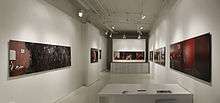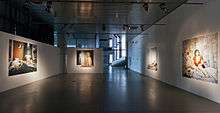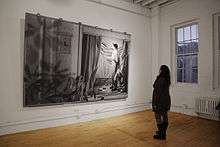Hrvoje Slovenc
| Hrvoje Slovenc | |
|---|---|
| Born |
November 22, 1976, Zagreb, Croatia |
| Nationality | Croatian |
| Education |
Yale School of Art (MFA) The City College of New York (BA) Zagreb University (MS) |
| Known for | Photography |
| Notable work |
Marble Hill (chapters: Home Theater, Harry Black, Portraits and Marble Hill) Breathing in Kabwe -Partners in Crime |
Hrvoje Slovenc (born 1976, Zagreb, Croatia) is a Croatian fine art photographer based in New York City. He holds MS in Biochemistry from University of Zagreb and MFA in Photography from Yale University School of Art.
His photographs have been exhibited in dozens of shows nationally and internationally including Museum of Contemporary Photography in Chicago,[1][2] Museum of New Art in Detroit, The Bronx Museum of the Arts,[3] Museum of Contemporary Art in Zagreb,[4][5] Croatia, Museum of Modern and Contemporary Art in Rijeka, Croatia, and Young Artists’ Biennial in Bucharest, Romania. Also, he is a recipient of London Photography Award, International Photography Award, Golden Light Award, Photography Now Award, BRIO Award,[6] as well as Mortimer Hays-Brandeis[7][8] and Alice Kimball English Traveling Fellowships.
Slovenc’s work is in the permanent collections of Museum of Contemporary Photography in Chicago, as well as Museum of Contemporary Art and Museum of Arts and Crafts in Zagreb, Croatia.
Slovenc was part of 2011 AIM residency program at The Bronx Museum of Art.[9] Slovenc has been a visiting artist at institutions including Drew University, The City College, LaGuardia Community College, Yale University, and Parsons The New School of Design.
Major Works
Since 2007, Slovenc has completed three major bodies of work and exhibited them internationally. In his latest work, Marble Hill, which consists of four distinct chapters, Slovenc focuses on his neighborhood in the Bronx. He uses photography, sculpture, set design, performance, and video to transform this real Bronx neighborhood into the author’s imaginary and metaphorical world nested between fantasy and reality. Slovenc is interested in life as a form of theater; particularly in ways domestic spaces have been acted in and acted upon. He is intrigued by the "scenes" people construct in their homes, as well as the roles people play in their daily lives, with all the semiotic and allegoric referents. In the series Partners in Crime, Slovenc creates wedding portraits of long term same sex couples. Inspired by late nineteenth-century cabinet cards, Slovenc photographs these couples to appear both physically and emotionally disconnected. In conflating images of stiff, traditional marriage poses and contemporary domestic spaces, Slovenc captures the public face that society mandates for same-sex couples. For the series Breathing in Kabwe, Slovenc traveled to Kabwe, Zambia to photograph the effects of lead pollution on the local population. With photographs and text, Slovenc has transformed a typical documentary subject matter in such a way that it has become not only about the observed or the observer as individual entities, not about “us” or “them” as two very distinct cultures, but primarily about the relationship between the two.
Marble Hill (2010-2013)
This complex body of work consists of four chapters: Home Theater, Harry Black, Portraits and Marble Hill. Marble Hill is a real neighborhood in the Bronx where Slovenc resides. The name also evokes a fantastical place reminiscent of a fairy tale. In this world, domestic spaces look like stage sets and intimate relationships are mere illusions created for a camera. Even moments of great tragedies appear to be theatrical. In each chapter, Slovenc uses different visual language to present daily life as a hyperreal, scripted construct.

Chapter I: Home Theater (2010)
In Home Theater, Slovenc photographs domestic spaces in which sadomasochistic sex acts are taking place. These images grew out of his personal experience in which he solicited people on numerous sex websites where he presented himself as an S&M practitioner. Even though the images are of the actual, lived-in domestic spaces, they appear to be artificial, hyperreal, grand, and with a slightly distorted perspective, as if constructed as sets for a movie or a play. Slovenc is interested in the performance aspect of our daily lives. What particularly fascinates him is the idea of a domestic space as a "scene" in which we perform our daily routines. By photographing the homes of S&M practitioners in particular, and by contrasting the performance spaces with traditional domestic spaces, Slovenc ultimately questions the notion of the latter as something that is spontaneously, creatively designed or "authored" by us as individuals.
Chapter II: Harry Black (2011)
In spring of 2011, Slovenc moved in with a complete stranger, an older gentleman–Harry Black. For months he photographed their relationship, creating a catalogue of images that resembled photographs one would find in a family photo album. Slovenc used photography and video to create an illusion of intimacy between two strangers. For the installation in the Bronx Museum, Slovenc recreated Black’s living room, replacing all the photographs of Black’s loved ones with the images of the constructed intimate relationship.

Chapter III: Portraits (2012)
For this chapter, Slovenc turned his camera toward his family and friends. He placed his subjects in their bedrooms, posed them in classical poses and photographed them. In the resulting images, his models failed to fully realize the roles they should play in the intimacy of their bedroom spaces: they should be relaxed, seductive and intimate, but they were not. Slovenc revealed cracks in our identity roles, small signs that indicated that this was a play. These photographs are presented as large-scale photo wallpapers.

Chapter IV: Marble Hill (2013)
On the cover of the 1966 book “The Photographer's Eye” by John Szarkowski is a black and white photograph by an unknown author that shows the interior of an apartment. While working on Home Theater, Slovenc came across an interior that was a contemporary copy of the mentioned interior. Through a set of unfortunate circumstances, the apartment (that was just a few blocks from Slovenc’s apartment in the Marble Hill part of the Bronx, NY) burned down. Slovenc rebuilt the apartment as a scaled down diorama, lit it on fire and photographed it. All the photographs in this chapter originated, as the author explained, from his own version of “Alice in Wonderland”; almost as if the photographs were stills from a post-surreal motion picture. “Moments shown in the photos could occur during the burning of the apartment. Plausible tenants pose for the camera, like in some reality TV show, just moments before they ran out.” – Leila Topic, a curator from the Museum of Contemporary Art in Zagreb, Croatia has written. Impression of theatricality of space and surrealism of the scene is enhanced by the author playing with sizes of photographic enlargements, and awkward spatial relationships within the compositions.
Breathing in Kabwe (2008)
Funded by the Mortimer-Hays Brandeis Traveling Fellowship, Slovenc traveled to Kabwe, Zambia to photograph the effects of lead pollution on the local population. In preparing for the trip, and especially during his stay there, the initial idea evolved to include not only an illustrated essay about people living in an entirely lead-tainted environment but also a deconstruction of the act of photographing the Other. Throughout the months Slovenc lived in Kabwe, he was only too aware of himself, and his own cultural positioning that constituted a very powerful filter through which he viewed things. Rather than privilege either verbal or visual text as the more "authentic," i.e. closer to "reality," Slovenc showed the way in which each type of representation imparts a small, though important, perspective on what he came to decipher as "the real." Ultimately the project has become part travel journal, part interview, part documentary, part autobiography, and part revelation. In short, this project is Slovenc’s way of approaching a typical documentary subject matter in such a way that it has become not only about the observed or the observer as individual entities, not about “us” or “them” as two very distinct cultures, but primarily about the relationship between the two.
Partners in Crime (2007)
Partners in Crime focuses on same-sex couples that have been living together for an extended period of time, eighteen years on average. The idea was inspired by late nineteenth-century wedding portraits and the professional techniques employed in them. While most of the earlier works were produced as cabinet cards, shot in studios with artificial backgrounds, Slovenc’s reconstructions are in color, taken in the couples' homes. The purpose is to demonstrate the mundane quality of what can only be seen as a marriage setting. In these photos, the author captures the public face that society mandates for same-sex couples. These couples appear to be both physically and emotionally disconnected because in many ways, both subtle and overt, that is how they are told they should behave. Thus in conflating images of stiff, traditional marriage poses and contemporary domestic spaces, Slovenc has sought to normalize what is still, at best, a hotly contested relationship in American society.
Public collections
- Museum of Contemporary Photography, Chicago, IL.[10]
- Museum of Contemporary Art, Zagreb, Croatia.[11]
- Museum of Arts and Crafts, Zagreb, Croatia.[12]
Exhibitions
- Museum of Contemporary Art, Zagreb, Croatia.
- Helac Fine art, New York, NY
- Garis&Hahn, New York, NY.
- Vienna Fair, Vienna, Austria.
- Young Artists' Biennial, Bucharest, Romania.
- Museum of Modern and Contemporary Art, Rijeka, Croatia.
- Museum of Arts and Crafts, Zagreb, Croatia.
- Atlanta Celebrates Photography, Atlanta, GA.
- The Bronx Museum of the Arts, New York, NY. Biennial 2011.
- Museum of New Art, Detroit, MI. New Media, Sex, and Culture in the 21st Century.
- Michael Mazzeo Gallery, New York, NY. Home Theater.
- Galerija Marisall, Zagreb, Croatia. Novi Likovni Izricaji.
- Eight Veil Gallery, Los Angeles, CA.
- David Weinberg Gallery, Chicago, IL.
- Jason McCoy Gallery, New York, NY.
- Philadelphia Photo Arts Center, Philadelphia, PA. Dream Nation.
- 25CPW, New York, NY. Stranger than Fiction.
- Kitchen Habitat, New York, NY. Objects in the Mirror.
- 2010 Art Chicago, Chicago, IL. New Insight.
- Longwood Art Gallery, New York, NY. Anthem: an all-American dystopia.
- 2009 Pingyao International Photography Festival, Pingyao, China. Breaking Boundaries II.
- Parachute Factory Gallery, New Haven, CT. Family Business.
- Museum of Contemporary Photography, Chicago, IL. Relative Closeness: Portraits of Family and Friends.
- Vollitant Gallery, Austin, TX. Tunnel Vision: Parading Down the Aisle.
- Farmani Gallery, Los Angeles, CA. IPA Best of Show.
- Center for Photographic Art, Carmel, CA. Annual Center Awards Exhibition.
- Northwest Art Center, Minot, ND. Americas.
- Gallery 214, Montclair, NJ. Taboo.
- Go Fish Gallery, New York, NY.
References
- ↑ "Relative Closeness - June 14 - August 7, 2007". Museum of Contemporary Photography, Columbia College, Chicago. Archived from the original on 2007-07-10. Retrieved 6 November 2013.
- ↑ "Relative Closeness: Photographs of Family and Friends | Museum of Contemporary Photography". Mocp.org. 2007-08-08. Retrieved 2013-10-28.
- ↑ "Bronx Calling - First AIM Biennial". Bronx Museum. Retrieved 6 November 2013. --via Hrvoje Slovenc.
- ↑ "Iz Programa". Muzej suvremene umjetnosti Zagreb. msu.hr.
- ↑ "Marble Hill - Hrvoje Slovenc - MSU - 15.3. - 5.4.2013 catalog". Zagreb, Croatia: Galerija Marisall. 2013. Archived from the original on 2013-11-07. Retrieved 6 November 2013.
- ↑ "Current and recent winners - Bronx Council On The Arts". Bronxarts.org. Retrieved 2013-10-28.
- ↑ "2007-2008 | Past Recipients | Mortimer Hays-Brandeis Travelling Fellowship | Brandeis University". Brandeis.edu. Retrieved 2013-10-28.
- ↑ "Two Recent Ccny Graduates Awarded Mortimer Hays-Brandeis Fellowships For Photography Projects Abroad – Cuny Newswire – Cuny". .cuny.edu. 2007-06-07. Retrieved 2013-10-28.
- ↑ "AIM". Bronx Museum of the Arts. 2013-09-03. Retrieved 2013-10-28.
- ↑ "Museum of Contemporary Photography". Mocp.org. Retrieved 2013-10-28.
- ↑ "Muzej suvremene umjetnosti Zagreb". Msu.hr. Retrieved 2013-10-28.
- ↑ Museum of Arts and Crafts website.
External links
- Official website
- Biography.
- Michael Mazzeo website.
- Galerija Marisall website.